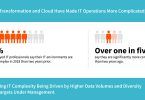In the always-on, competitive digital economy, a high-performance customer experience can mean the difference between business success and failure. However, today’s complex application ecosystem has made it increasingly difficult to ensure optimal performance across digital services and applications. Application performance management (APM), therefore, must evolve to provide real-time visibility into the app landscape—and uncover exactly what is impacting customer journeys.
Currently, there are two main technologies used to measure application performance: synthetic monitoring and real user monitoring. Before defining these two approaches and explaining the benefits and limitations of each, it is important to understand the business impact of poor digital performance.
The Strategic Importance of Application Performance
When it comes to expectations, customers are primarily looking for two key attributes — availability and high performance. Missing the mark on either of these can negatively impact your business in several ways.
Lost Revenue
One out of two people expect a page to load in two seconds or less. Slower page response times lead to increases in page abandonment with 40% of users stating that they would abandon a page if it did not load within three seconds. If you run an ecommerce site with $100,000 per day in revenue, a 1-second page delay could potentially cost you $2.5 million in lost sales each year. For online retail giants like Amazon, a similar delay would be even more catastrophic, resulting in estimated lost sales of $1.6 billion per year.
According to a 2015 Google study, if a website or app is slow to load or clumsy to use, 29% of smartphone users immediately move to a different app or website to satisfy their needs. Of those who switch, 70% do so because of slow loading times.
Furthermore, the Radaware Spring 2015 State of the Union for Page Speed & Web Performance study showed that for every second of load time improvement, Walmart’s website saw a 2% increase in conversion rate.
Decreased Long-Term Loyalty
Poor digital performance also affects your ability to retain customers long-term. Of note, 75% of users who experienced a site that freezes, crashes, is too slow or involves a complicated checkout process would not consider buying from that site in the future. A study conducted by Strangeloop/Radware found that when a sampling of webpages was slowed down for 12 weeks, it took 6 weeks for return traffic to bounce back to normal levels.
Reputational Damage
Furthermore, poor web experiences lead to frustrated customers most of whom will share their negative experiences with friends and family. In the worst case scenario, some customers will take to social media to comment or complain. Even one negative review can lead to 30 lost customers, according to a survey by Convergys Corp.
Higher Help Desk Costs
Poor web performance also impacts the IT organization’s budget because more resources are needed to resolve issues that arise when customers encounter obstacles using your site. Approximately 85% of organizations engage more than 6 people to resolve known issues.
Productivity Losses
Apart from placing a strain on DevOps, underperforming web-based internal applications can also impede employee productivity. According to an IHS study, information and communications technology (ICT) outages cost enterprises approximately $700 billion per year, of which 78% is lost productivity.
Deploying an effective application performance management strategy helps to mitigate downtime risk and ensure that your business delivers a user experience that exceeds customer expectations. But which monitoring technique is ideal for your business-critical needs?
What is Synthetic Monitoring?
Synthetic monitoring, also called synthetic transaction management (STM), uses scripted recordings to simulate the expected path a user would take through an application. This approach allows IT to proactively measure the availability and performance of applications and related infrastructure. You control the parameters such as specific locations and the frequency of tests.
Benefits of Synthetic Transaction Monitoring
- STM allows you to monitor the performance and reliability of your applications 24 x 7, even for apps and services that are not currently being accessed by live customers.
- Utilizing this approach, if your application goes down, you will be notified first (rather than your end user). This will help you respond faster as well as protect brand reputation.
- Today’s applications are increasingly dependent on third-party applications which add to the complexity of successful performance management. However, synthetic monitoring allows you to proactively check service-levels to understand the performance impact under-performing third-party content is having on customer experience. In this way, you can hold third-party vendors accountable and mitigate business risk.
- According to IDG research, 90% of all organizations today either have applications running in the cloud or are planning to move to the cloud in the next 36 months. If your organization is leveraging a SaaS solution for email, document storage, sharing, or other critical business functions, then synthetic monitoring will allow you to gauge the performance and availability of these applications.
- Synthetic monitoring can also assist your organization in identifying, testing and optimizing new applications for deployment. This approach helps you to predict application health before introducing a new application.
- Synthetic monitoring is critical to a Shift Left testing approach – which can help reduce costs and mitigate risks earlier. This is because it allows you to test prior to launch.
- Additionally, synthetic scripts can be pointed to external applications and services to determine how your user experience stacks up against the competition. This is a critical component for defining goals, setting IT benchmarks, and gaining a competitive edge in your industry.
Limitations of Synthetic Monitoring
Synthetic monitoring does not provide real-time, real-world visibility. In other words, it cannot definitively tell you what specific end users will actually experience because it is difficult to gauge all of the atypical or unpredictable variables that could potentially impact a real-life customer experience through each stage of the user journey.
What is Real User Monitoring?
Real user monitoring (RUM) or end-user experience monitoring (EUEM) provides insight into how actual users interact with your website or application. Real user monitoring gathers data across physical and cloud environments, the internet, corporate networks, and content delivery networks (CDN). The technology delivers accurate, real-time transaction and detection information about sessions, applications, and content levels.
RUM involves passive data collection from probes in the cloud or on premises that capture application traffic or by active data collection from instrumenting the applications themselves on the backend or by web page monitoring on the front end. This approach allows you to identify problems and allocate resources based on a clearer understanding of demand. Passive EUEM is generally enabled through network-based packet capture, providing visibility into all users continuously without imposing a load on servers or applications. Active EUEM is enabled by Javascript injection of the webpages at runtime or manually.
Benefits of Real User Monitoring
- Passive EUEM allows you to monitor traffic and page performance.
- This approach allows you to evaluate application health through generated reports of real user activity.
- You can often detect and diagnose the root cause of problems. For example, you can pinpoint problems with specific browsers or locations that would not be revealed using synthetic testing.
- You can generate reports to ensure that service level agreements with third-party vendors are being met.
- You can identify and track a variety of usage trends around key performance indicators such as the number of transactions by region.
- You will be able to monitor the end-user user experience and prioritize issues based on end-user impact thereby ensuring customer satisfaction.
Limitations of Real User Monitoring
The major drawback of real user monitoring is that it often does not collect data if there are no users on the site and it typically cannot identify or gauge a loss of network connectivity or where it occurred (DNS, TCP Connection, Server, etc.). Although passive EUEM does not allow you to monitor the performance of a new application or feature prior to launch, you can use active instrumentation as well as synthetic monitoring for development.
Synthetic Monitoring and Real User Monitoring Working Together
On their own, synthetic testing and real user monitoring do not provide the best view of the application landscape that organizations need in order to respond to the dynamic demands of today’s customers. However, correlating data from both of these approaches offers the ability to drill down into specific application issues and circumvent the intrinsic shortcomings in order to provide the organization with full visibility of their customer experience—both real and potential.
With this analysis in hand, you can gauge how fast your site needs to be in order to ensure customer satisfaction and even gain a competitive edge.
App-centric Infrastructure Monitoring
BMC’s TrueSight AppVisibility is transforming digital enterprises through application-centric infrastructure monitoring. This approach shows application tiers and related events in a single view, making it easy to drill down for further analysis.
Centralizing visibility into your app ecosystem and IT infrastructure to see the entire application delivery chain—from infrastructure and code to the customer experience—allows you to understand the health and performance of diverse application architectures from the customer’s perspective. You can:
- Gain insight into performance with application context views of all the tiers of the application delivery chain.
- Easily perform a deep dive to view events, device performance, application health, and launch probable cause analysis or log analysis.
- Diagnose root causes of degraded performance and assign events to the right experts from a single source of truth.
Everyone benefits when applications run at their best. Furthermore, in this digitally competitive business environment, fast and reliable digital experiences enable organizations to empower business users and interact with customers in powerful new ways that drive growth and competitive advantage. Improving web performance of applications and digital services through a combination of synthetic testing and real user monitoring provide the starting point to unlock this digital transformation.







